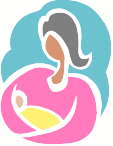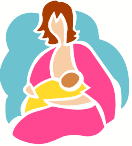 Having been told that my initial breastfeeding difficulties – cracked, bleeding, excruciatingly painful nipples – were quite normal (despite what the official literature said), I was looking forward to the three week deadline after which everything would be functioning as it should. I was, however, slightly perturbed by the fact that as he deadline approached, no improvement was evident. In fact, my nipples were getting much, much worse. My husband expressed genuine concern that C was going to chew one of them off! By this stage, the bleeding had stopped, but it had been replaced by deep, ulcerated gashes on the outside edge of each nipple. I dreaded feeding, and as C wanted to do so 10-12 times a day, I spent all 24 hours either in pain, or anticipating its imminent start.
Having been told that my initial breastfeeding difficulties – cracked, bleeding, excruciatingly painful nipples – were quite normal (despite what the official literature said), I was looking forward to the three week deadline after which everything would be functioning as it should. I was, however, slightly perturbed by the fact that as he deadline approached, no improvement was evident. In fact, my nipples were getting much, much worse. My husband expressed genuine concern that C was going to chew one of them off! By this stage, the bleeding had stopped, but it had been replaced by deep, ulcerated gashes on the outside edge of each nipple. I dreaded feeding, and as C wanted to do so 10-12 times a day, I spent all 24 hours either in pain, or anticipating its imminent start.
‘A mother’s guide to breastfeeding’, provided by my health visitor, wasn’t particularly reassuring. The only place it mentioned what I had finally come to recognize as fissures was in the ‘problem solving chart’ on the back cover. Apparently, this meant that C had tongue tie! I thought this was unlikely, as we’d seen her sticking her tongue right out of her mouth. Nevertheless, the information sent me into another panicked state, and I was on the phone yet again to the maternity unit.
On the next visit, the midwife assured me that C didn’t have tongue-tie. In fact, she seemed remarkably unperturbed by what I felt was the pretty horrifying sight of my nipples. Although she didn’t know quite what the problem was, she acknowledged that some mothers have these difficulties, and that many of them give up as a result. She was confident that things would improve, and said that I should consider getting a nipple shield to make things more bearable in the short term. She also suggested I call a breastfeeding helpline. I was sceptical they would be able to tell me anything I didn’t already know, but by this point anything was worth a try.
 The first couple of days at home were pretty breezy. Before I left hospital I was assured by two midwives that C was latching on properly – cheeks puffed out, chin pumping, ears wiggling – so I was confident we had the technique sorted. Family visited and I assured them everything was going well, demonstrating our successful feeding on several occasions. By the time I got to day four, however, things weren’t quite so easy. Accompanying the hormone-induced plunge into despair inadequately named ‘the baby blues’ (that coincides with the start of proper milk production) was a serious deterioration of my nipples.
The first couple of days at home were pretty breezy. Before I left hospital I was assured by two midwives that C was latching on properly – cheeks puffed out, chin pumping, ears wiggling – so I was confident we had the technique sorted. Family visited and I assured them everything was going well, demonstrating our successful feeding on several occasions. By the time I got to day four, however, things weren’t quite so easy. Accompanying the hormone-induced plunge into despair inadequately named ‘the baby blues’ (that coincides with the start of proper milk production) was a serious deterioration of my nipples.